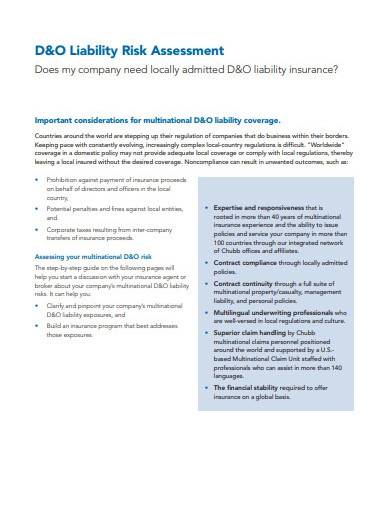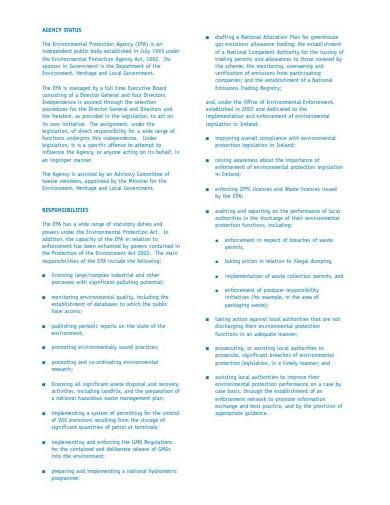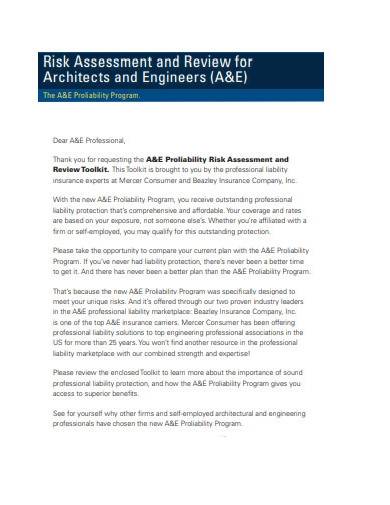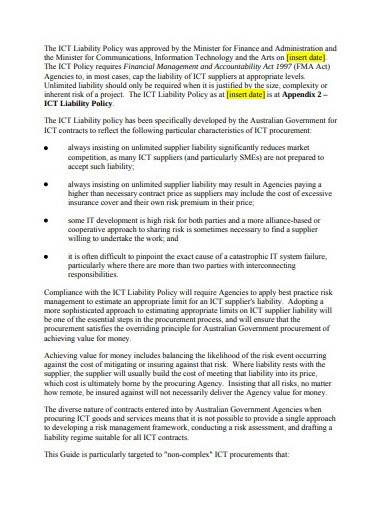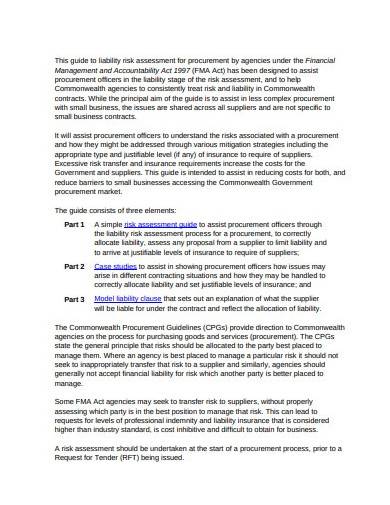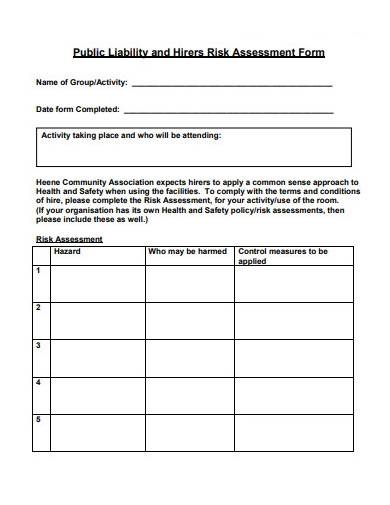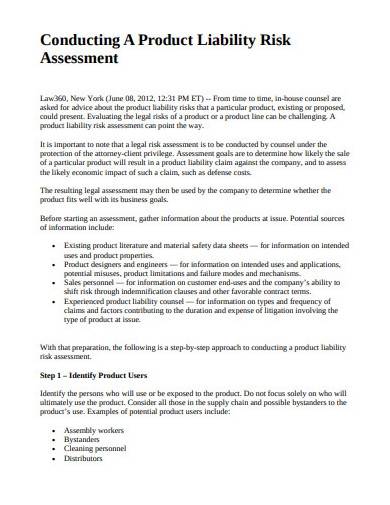Risks are everywhere and can be faced by anyone. Even the President of the United States of America and every country leader deals with risks. But, unlike the President who has the Secret Service, business owners and organizations have to analyze what to do to resolve risks, especially ones that involve the entire organization’s liability. And that’s when a liability risk assessment comes in hand. So, if you need help with the assessment, read on to know more!
FREE 10+ Liability Risk Assessment Samples and Templates in PDF
1. Liability Risk Assessment Template
2. Professional Liability Risk Assessment Survey
3. Environmental Liability Risk Assessment
4. Liability Risk Assessment Worksheet
5. Risk Assessment and Review Template
6. Liability Risk Assessment Sample
7. Liability Risk Assessment Guide
8. Public Liability and Assessment Form
9. Risk Assessment and Liability Form Sample
10. Product Liability Risk Assessment Proposal
11. Professional Liability Risk Assessment
What Is a Liability Risk Assessment?
A liability risk assessment is a type of examination or evaluation conducted to identify possible responsibilities that an organization or a person will have towards something, someone, or to an unfortunate incident. By doing the assessment, such liabilities and its accompanying costs or expenses will be avoided. For example, when a vehicle owner lends his car to another person, he should be aware of the possibility that the borrower may get into an accident. And if the accident was due to a failure in the vehicle, then the owner will be held liable, especially in the field of law if ever the borrower will file a lawsuit.
How to do a Liability Risk Assessment
Getting the right insurance policies is one of the top ways to protect a business from common liability risks, according to Kneller Insurance Agency. But, not only business owners benefit from liability risk insurance, but also private individuals and property owners. However, a good insurance policy is only a step, since there should also be an evaluation of the risks and preparations. And for that, you should keep the following tips in mind to start your liability risk assessment:
1. Identify the Risks and Liabilities
You should first identify and list the risks, and then proceed to name the liabilities that you might have with each risk. The best method of doing this is by getting the thoughts of experts or a team. Also, as you make a list, categorize them into groups. Examples of groups would be ones for financial risks, product risks, and construction risks.
2. Establish a Liability Risk Procedure
How will your company deal with risks and liabilities? What specific steps should you take? The answers to those questions should lead you to establish a liability risk procedure and plan. It must be detailed and well thought out. Also, it should include all the steps and guidelines for every risk that you have listed beforehand.
3. Know the Legal Aspects
Knowing your rights, limitations, and benefits can help you control your liabilities in particular risks, especially if you’re a business owner. In specific, you should know the business laws, insurance laws, state laws, and every policy or regulation that you have to follow. You must also understand those related to business tax payments, liquidity risks, non-compliance penalties, and who your legal team is.
4. Identify the Affected Parties
In every risk, there will be someone who will get affected. For instance, if the liability risk is in the financial area of your company, then the accountant, payroll officers, and other financial members are the affected ones. On the one hand, if you are running a new business, then you should have to manage your capital market risk and inform your investors and co-owners. By identifying the affected parties, you’ll be able to get them involved and discuss what the best decision would be for addressing the risks of unintended liabilities.
5. Document Everything
Everything that you have done or accomplished as part of the risk assessment should be well-documented. That includes the assessment forms from every assessor or evaluator, the suggestions of the involved parties, the business plan, rules, and regulations to implement, updated company bylaws, and agreement forms. And, you must update the liability risk management plans and conduct an assessment regularly, such as annually or every six months.
FAQs
Why are liability risk assessments important?
Liability risk assessments are important because it serves as a preparation method for companies, private individuals, and everyone who may be dealing with unintended responsibilities and liabilities. With a complete and thorough assessment, the involved will be able to foresee and prevent the risks along with the liabilities.
Do I need to review my business contracts and agreements over time as part of the liability risk assessment?
Yes, you have to review and check any document, legal form, and contract that you have signed. Remember that liabilities are responsibilities, which means that there are also risks in the contracts. The most common type of business contract that you need to review and ensure that you know the contents is the service contract. In specific, it contains sections that detail the liability statements and penalties that you will face for the services that you will provide or receive when an incident or accident occurs.
Can I waive my liabilities?
Yes, you can choose to waive your liabilities as part of your risk assessment and management plans. But, you have to make sure that you put the liability waiver in writing, and that the involved parties will agree and sign the waiver.
Liability risk assessments help anyone to be aware of the risks, hazards, and liabilities. It serves as a map and a guide and therefore, must be up-to-date with accuracy. So, don’t waste any more time and download our free sample forms and templates for your liability risk assessments now!
Related Posts
FREE 10+ Writing Journal Entry Samples and Templates in MS Word | PDF
FREE 10+ Double Entry Journal Samples and Templates in MS Word | PDF
FREE 5+ Stock Ledger Samples and Templates in MS Excel | PDF
FREE 10 + Revenue Recognition Samples & Templates in PDF | MS Word
FREE 11+ Liability Insurance Application Samples and Templates in MS Word | PDF
FREE 11+ Petty Cash Reconciliation Samples and Templates in MS Excel | PDF
FREE 10+ Reconciliation Statement Form Samples and Templates in MS Word | PDF | MS Excel
FREE 10+ Annuity Disclosure Form Samples & Templates in PDF
FREE 9+ Absorption Costing Samples & Templates in PDF | MS Word
FREE 10+ Prepaid Expenses Samples and Templates in PDF | MS Excel
FREE 7+ Depreciation Worksheet Samples & Templates in PDF | MS Word
FREE 10+ Turnover Ratio Analysis Samples and Templates in PDF
FREE 11+ Cost Volume Profit Analysis Samples & Templates in PDF | MS Word
FREE 10+ Bank Reconciliation Statement Samples and Templates in PDF | MS Word
FREE 9+ Balance Sheet Reconciliation Samples & Templates in PDF | MS Word

